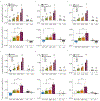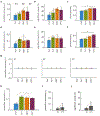High-precision mapping reveals the structure of odor coding in the human brain
- PMID: 37620443
- PMCID: PMC10726579
- DOI: 10.1038/s41593-023-01414-4
High-precision mapping reveals the structure of odor coding in the human brain
Abstract
Odor perception is inherently subjective. Previous work has shown that odorous molecules evoke distributed activity patterns in olfactory cortices, but how these patterns map on to subjective odor percepts remains unclear. In the present study, we collected neuroimaging responses to 160 odors from 3 individual subjects (18 h per subject) to probe the neural coding scheme underlying idiosyncratic odor perception. We found that activity in the orbitofrontal cortex (OFC) represents the fine-grained perceptual identity of odors over and above coarsely defined percepts, whereas this difference is less pronounced in the piriform cortex (PirC) and amygdala. Furthermore, the implementation of perceptual encoding models enabled us to predict olfactory functional magnetic resonance imaging responses to new odors, revealing that the dimensionality of the encoded perceptual spaces increases from the PirC to the OFC. Whereas encoding of lower-order dimensions generalizes across subjects, encoding of higher-order dimensions is idiosyncratic. These results provide new insights into cortical mechanisms of odor coding and suggest that subjective olfactory percepts reside in the OFC.
© 2023. This is a U.S. Government work and not under copyright protection in the US; foreign copyright protection may apply.
Conflict of interest statement
Competing interests
The authors declare no competing interests.
Figures















Similar articles
-
Smell the Label: Odors Influence Label Perception and Their Neural Processing.J Neurosci. 2025 Apr 2;45(14):e1159242024. doi: 10.1523/JNEUROSCI.1159-24.2024. J Neurosci. 2025. PMID: 39993837
-
Learning to smell the roses: experience-dependent neural plasticity in human piriform and orbitofrontal cortices.Neuron. 2006 Dec 21;52(6):1097-108. doi: 10.1016/j.neuron.2006.10.026. Neuron. 2006. PMID: 17178411 Free PMC article.
-
De Novo Emergence of Odor Category Representations in the Human Brain.J Neurosci. 2016 Jan 13;36(2):468-78. doi: 10.1523/JNEUROSCI.3248-15.2016. J Neurosci. 2016. PMID: 26758838 Free PMC article.
-
Function follows form: ecological constraints on odor codes and olfactory percepts.Curr Opin Neurobiol. 2009 Aug;19(4):422-9. doi: 10.1016/j.conb.2009.07.012. Epub 2009 Aug 9. Curr Opin Neurobiol. 2009. PMID: 19671493 Free PMC article. Review.
-
Localizing the human brain response to olfactory stimulation: A meta-analytic approach.Neurosci Biobehav Rev. 2022 Mar;134:104512. doi: 10.1016/j.neubiorev.2021.12.035. Epub 2021 Dec 27. Neurosci Biobehav Rev. 2022. PMID: 34968523 Review.
Cited by
-
Characterizing Olfactory Brain Responses in Young Infants.J Neurosci. 2025 Mar 12;45(11):e1780242025. doi: 10.1523/JNEUROSCI.1780-24.2025. J Neurosci. 2025. PMID: 39870525
-
Immersive interfaces for clinical applications: current status and future perspective.Front Neurorobot. 2024 Nov 27;18:1362444. doi: 10.3389/fnbot.2024.1362444. eCollection 2024. Front Neurorobot. 2024. PMID: 39664264 Free PMC article. Review.
-
Brain-wide pleiotropy investigation of alcohol drinking and tobacco smoking behaviors.Transl Psychiatry. 2025 Feb 20;15(1):61. doi: 10.1038/s41398-025-03288-5. Transl Psychiatry. 2025. PMID: 39979292 Free PMC article.
-
Exploring the feasibility of olfactory brain-computer interfaces.Sci Rep. 2025 May 26;15(1):18404. doi: 10.1038/s41598-025-01488-z. Sci Rep. 2025. PMID: 40419502 Free PMC article.
-
Smell the Label: Odors Influence Label Perception and Their Neural Processing.J Neurosci. 2025 Apr 2;45(14):e1159242024. doi: 10.1523/JNEUROSCI.1159-24.2024. J Neurosci. 2025. PMID: 39993837
References
-
- Leopold DA, Wilke M, Maier A & Logothetis NK Stable perception of visually ambiguous patterns. Nature neuroscience 5, 605–609 (2002). - PubMed
-
- Walsh V & Kulikowski J Perceptual constancy: Why things look as they do. (Cambridge University Press, 1998).
-
- Hudson R From molecule to mind: the role of experience in shaping olfactory function. Journal of Comparative Physiology A 185, 297–304 (1999). - PubMed
-
- Sell CS On the unpredictability of odor. Angewandte Chemie International Edition 45, 6254–6261 (2006). - PubMed
METHOD REFERENCES
Publication types
MeSH terms
Grants and funding
LinkOut - more resources
Full Text Sources

